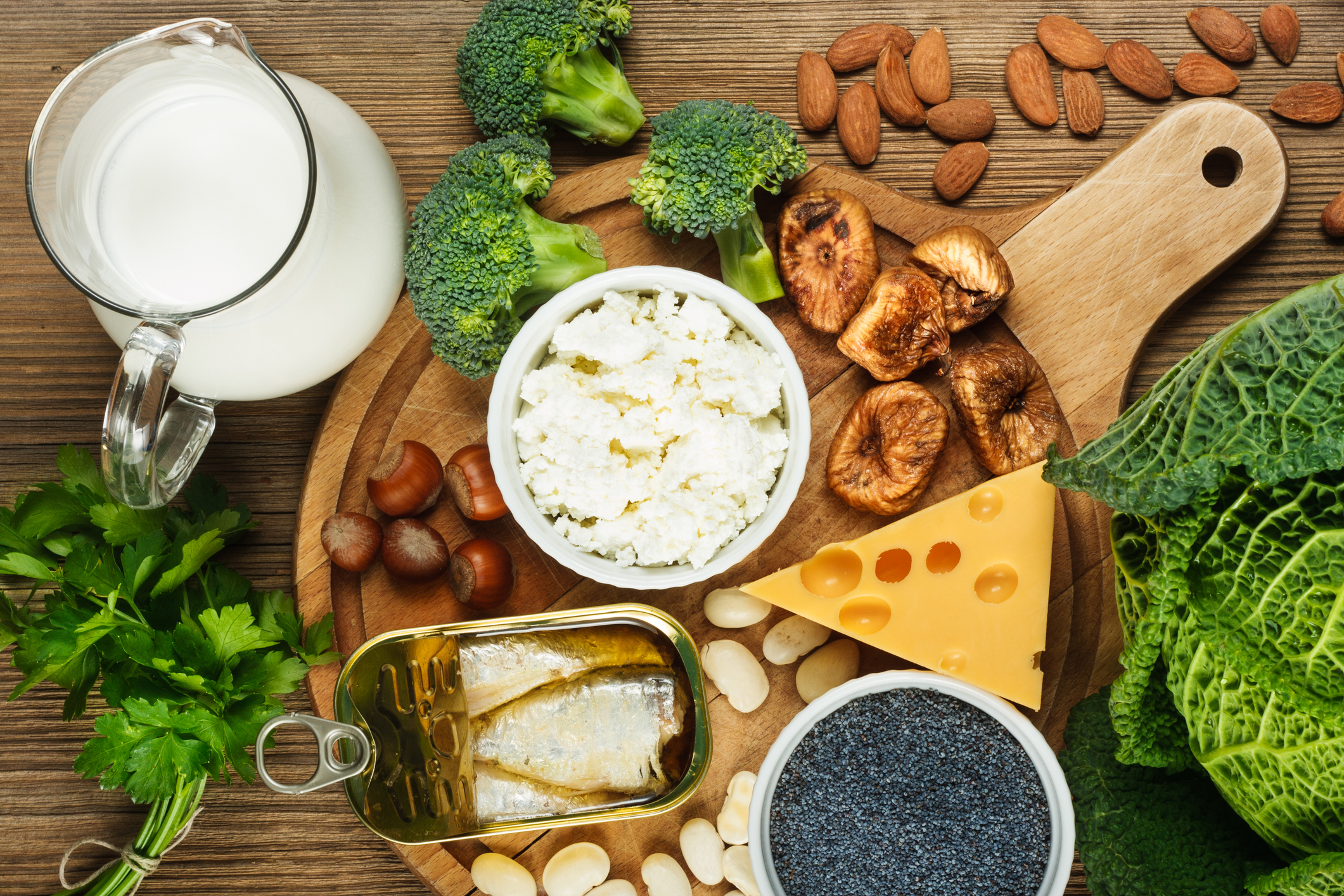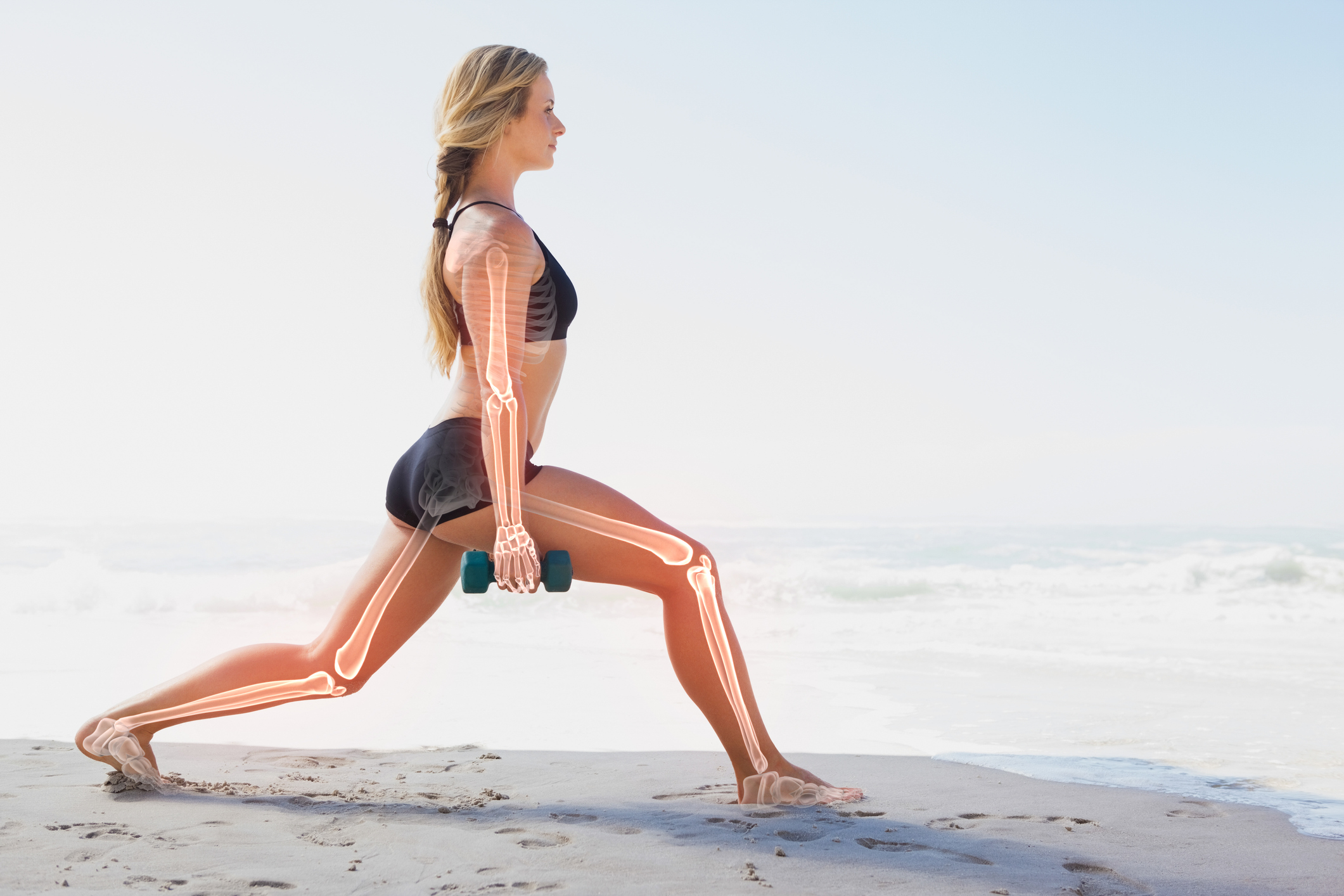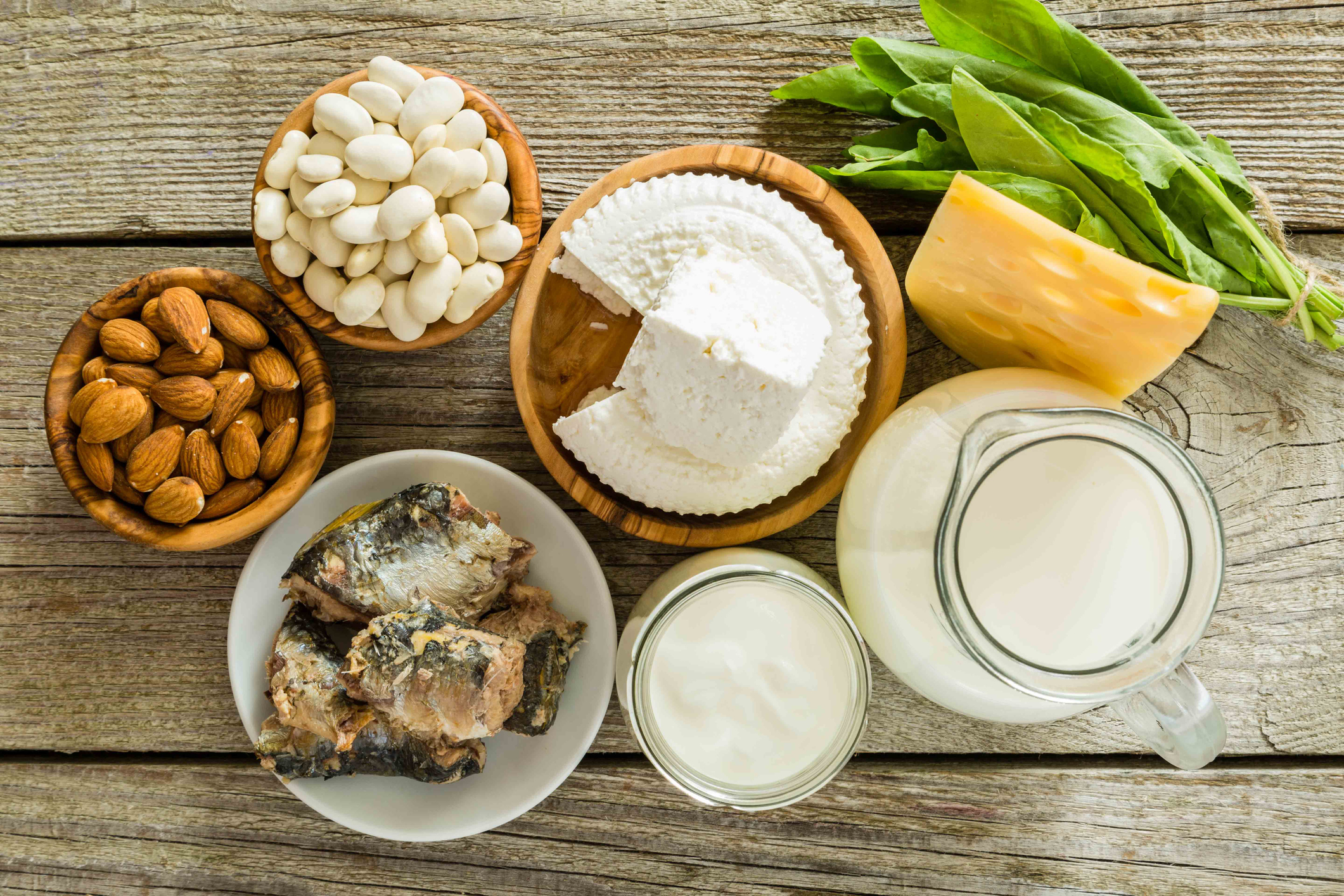Due to years of exposure to “Got Milk?” ads and the good old USDA food pyramid, most people understand that calcium – mainly found in dairy sources – is essential for building healthy bones.
And if you didn’t see those ads, chances are your mom or dad preached that you needed to “drink your milk” to become big and strong. Most conventional nutritional institutions, particularly the USDA, recommend men and women consume at least 3 cups of dairy a day.
So what’s up with the attention to calcium in the mainstream nutrition world?
And should we be paying attention?
WHY IS CALCIUM IMPORTANT
The rumors are true, calcium is essential for building strong bones. (Though it’s not the only factor that affects bone health.)
Calcium binds with phosphate to form hydroxyapatite, the rigid mineral component of our bones. In fact, 99% of the calcium in our bodies is incorporated and stored in our bones.
Ensuring that you are consuming adequate calcium throughout the life span to build and maintain a healthy bone mineral density is important to avoiding bone diseases like osteopenia, osteomalacia and osteoporosis.
Your bones will reach their peak bone mineral density by the time you reach around 30 years of age and continue to decline at different rates as we age.
By consuming enough calcium before you hit 30, you can build up your bone mineral density to help you cope with losses later in life. After 30, calcium is necessary to prevent any accelerated calcium loss from bones.
While most people know that calcium is found in bones, the 1% of calcium not found in the bones, while often overlooked, is vital to the healthy function of our bodies. This calcium can be found mostly in the cells and plays a role in cell signaling molecule.
In fact, calcium controls the signaling for many important processes in the body such as vasoconstriction/dilation, nerve impulse transmission, muscle contraction, hormone secretion and apoptosis (programmed cell death).
If someone isn’t consuming enough calcium in their diet, a hormone called PTH (parathyroid hormone) will be released into the blood to mobilize calcium stores from their bones to maintain adequate calcium levels for cell signaling purposes inside the cells. Therefore, by chronically under consuming calcium, bone density will suffer.
But, like with most (all?) nutrients, there is an appropriate balance with calcium.
Too much calcium in the blood can lead to calcification in all the wrong places. Calcium supplementation has been linked to calcification of arteries, kidney stones and may even promote biofilm development exacerbating fungal or bacterial infections in the GI tract.
One study found that the incidence of stroke and heart attacks increased by 30% in woman who were supplementing with 1000mg of calcium a day.
Even your bone health won’t benefit from high levels of calcium. Calcium use in older woman doesn’t reduce fractures and may possibly increase the risk of fractures.
So, in short, calcium appears to be a goldilocks nutrient. Both too much and too little can cause problems. You want to consume enough calcium to avoid any mobilization of calcium from your bones, while also avoiding to much that may build up in your soft tissues.
Easy peasy… right?

Paleo and Calcium
One of the major gripes the conventional nutrition community has against Paleo is the exclusion of calcium-rich dairy. They are adamant that it’s impossible to meet your calcium needs on a Paleo style diet.
While Paleo advocates promote the idea that we really don’t need that much calcium and it is relatively easy to consume enough from paleo friendly non-dairy foods. So, who’s right?
Both arguments have some validity, but neither is the full story. (Nutrition is fun!)
Let’s dive a little bit deeper into the Paleo side of the calcium-dairy argument.
The Paleo argument comprises of two parts. First, the Paleo-sphere promotes that our calcium needs are actually lower than dietary guidelines suggest. And there is some valid evidence that supports this point.
The current USDA recommended daily allowance (RDA) for calcium is 1000-1200 mg (varies slightly on age). On average, American women are consuming between 880-950 mg per day and American men are eating around 1200 mg a day.
While we don’t have any data specifically on Paleo eaters, it’s safe to say that most paleo eaters reduce their intake of calcium when they switch from a standard American diet, as dairy is fully excluded on a strict Paleo diet.
The question is, is this significant dietary calcium reduction a problem?
It could be!
HOW MUCH CALCIUM do we need?
Dr. Walter C. Willett, chair of the Harvard School of Public Health’s Nutrition Department, believes that only 600 mg of calcium per day is required to reduce bone fracture risk, but a little extra may be protective against colon cancer. He recommends shooting for 600 to 1000 mg a day.
He also warns agains the drawbacks of high calcium intakes, especially when dairy is the source since high dairy consumption is linked to ovarian and prostate cancer.
Paul Jaminet points out a couple of studies in his book The Perfect Health Diet that corroborate Dr. Willett’s recommendations. The first study looked to determine the amount of calcium per day that was needed to achieve calcium balance. (Excess calcium is excreted by the kidneys in the urine.)
The researchers found that 741 mg of calcium achieved this balance and additional calcium beyond this point is excreted in the urine. Another study found that the lowest fracture rates occurred at intakes between 700 to 900 mg of calcium a day.
Thus the Paleo community is correct in pointing out that with calcium, more is not better, and that we probably don’t need 1000 mg like the RDA suggests.
The second part of the paleo argument is that calcium needs can be easily attained through a calcium rich paleo sources.
Would you like to save this post?
Your email address is 100% safe and will never be sent spam.
While I think achieving adequate calcium intake on a strict, dairy-free Paleo diet is certainly possible, I don’t think adequate calcium intake can be easily achieved without careful planning or forethought. It’s actually common to see low calcium intake in my clients who are strictly avoiding dairy.
And while the dangers of overconsumption of calcium are frequently discussed, the Paleo community often underemphasizes the health consequences of too little calcium in the diet.

What are paleo sources of calcium?
There are 3 significant sources of calcium on strict Paleo: fish with bones, cruciferous vegetables, and nuts and seeds.
A can of sardines with bones has around 350 mg of calcium and canned salmon with bones usually has around 180 mg of calcium per serving. Cruciferous vegetables like collard greens, mustard greens, bok choy, broccoli and kale are good sources to boost calcium intake. Two ounces of almonds have about 150 mg.
Notice I didn’t mention bone broth.
Unfortunately bone broth, while nourishing for bone health in many ways, is NOT a good source of calcium. So don’t be drinking bone broth thinking you’re getting tons of calcium in it… because you’re not, unfortunately!
When looking at calcium it is also important to understand the differences in bioavailability (% absorbed compared to total consumed) between different calcium sources. Chris Masterjohn has pointed out the importance of considering the bioavailability of nutrients in certain foods. In particular, he discusses how spinach should not be considered a good source of calcium, because only 5% of the calcium is absorbed due to the high oxalates in the spinach that block absorption.
Almonds are also another paleo food that is touted as having a high calcium content, but it’s high phytate content leads to a much lower absorption rate than cruciferous vegetables. In comparison, cruciferous vegetables’ calcium absorption rate is around 50%, which is even higher than the calcium absorption rate from milk.
While I think some Paleo dieters are eating bone-in fish and lots of kale, many are not. There are probably thousands of people not consuming nearly enough calcium when they have eliminated dairy from their diet (this goes for vegans as well!)
So, I’d say the conventional nutrition world’s apprehension about lack of calcium in a Paleo diet is justified.
But I also don’t believe we all need 3 cups of dairy a day either.

DEEPER ISSUES WITH LOW CALCIUM PALEO DIETS
Here are some other health issues that can arise when you’re on a standard Paleo diet with no attention to your calcium intake.
Lead release from bones
As I discussed above, when calcium intake is under around 600 mg a day, calcium will be mobilized from the bones. This demineralization not only reduces bone mineral density, but it could lead to a large release of lead from the bones.
While lead poisoning has declined drastically in recent years, lead can be inherited from a mother who was exposed to lead. Inherited lead is stored in your bones and is released in higher quantities during pregnancy, lactation, menopause and when calcium intake is low.
Lead is toxic and can cause impaired communication, attention, memory, abstract thinking and motor skills. Researchers are also linking lead to problems associated with aging like kidney stones, hypertension and even dementia.
If you suspect you may have lead issues, it is important to work with a medical practitioner who can help you detox the lead properly and help you optimize your calcium intake to avoid rapid lead release from your bones.
Low calcium levels could also deplete your Vitamin D stores
When calcium is low, vitamin D stores will decrease in the body.
Vitamin D, like PTH, is an important regulator of blood calcium levels. When calcium levels are low, 25-OH Vitamin D stored in the liver will be converted to the most active form of Vitamin D (1,25-OH) to increase calcium levels in the blood. If Vitamin D is being chronically used to boost calcium levels, you could become deficient in vitamin D.
Vitamin D deficiencies have been linked to immune dysfunction and even autoimmune conditions. Vitamin D can modulate both our innate and adaptive immunity to help us fight infections. When vitamin D status is low from low calcium intake, it could result in chronic infections.
LOW CALCIUM + LOW CARB: A DANGEROUS COMBO FOR WOMEN
Many paleo dieters hoping to lose weight jump on the low carb paleo bandwagon. Eating too low carb while not consuming enough calcium can be double trouble for your bones.
Going too low carb will increase cortisol levels. Cortisol will reduce calcium absorption, further exacerbating the problem of low intake. Studies have linked high cortisol to low bone mineral density.
In addition, high cortisol levels can reduce estrogen, which has bone protective properties. This lack of estrogen will further compound the bone demineralization effects of both high cortisol and low calcium intake.
Histamine Intolerance?
I have seen a lot of histamine issues in my practice and I theorize it could be a result of low calcium intake from paleo diets. Calcium appears to play a role in the regulation of histamine secretion from mast cells. Too much or too little could lead to histamine issues.
While this is just a theory of mine, it does surprise me how many patients I’ve worked with who have developed severe histamine intolerance symptoms after eating a low carb Paleo diet for several months or years.
I’m still investigating the contributing factors here (like gut health, mineral imbalances, etc.) but I wouldn’t be surprised if calcium was somehow involved.

ARE YOU GETTING ENOUGH?
The majority of available evidence suggests that we should strive to consume at least 600 mg of calcium a day, with 1000 mg/day being the upper limit. Here are some simple steps to make you sure you are getting all the calcium you need:
- Track your intake of calcium for three days to determine how much you are eating. This process will give you a better sense of your baseline calcium intake, so you can determine if your intake is sufficient or how much more calcium you need to add to reach that 600-800 mg range.
- If you tolerate dairy, but are currently eating paleo, consider adding dairy back into your diet. High quality, full-fat dairy from grass fed sources can be a simple way to add calcium into the diet when Paleo sources are not quite meeting your needs. Many people find they tolerate raw dairy better than pasteurized (I am one of those people!)
- A healthy mix of Paleo and dairy sources to meet calcium needs is probably the best strategy.
- While dairy is an excellent source of calcium, I don’t necessarily think we should be relying solely on dairy to meet our calcium requirements like the 3 cups of dairy a day recommendation from the Dietary Guidelines suggests.
- In addition, it’s best to stick to dairy that is rich in probiotics with a lower lactose content like hard cheeses, kefir and yogurt. Dairy product’s derived from goat’s milk also have a lower lactose content and may be better tolerated by individuals with lactose sensitivities.
- If you don’t tolerate dairy, you can increase intake of paleo sources of calcium like bone-in fish, sesame seeds, blackstrap molasses, and cruciferous vegetables.
- If you don’t like these foods or don’t feel like you can consume them on a regular basis, then supplementing to reach that 600-800 mg range is also an option. I like a calcium supplement that is balanced in a 1:1 ratio with magnesium like this one.
Bottom Line? Calcium matters
Achieving adequate calcium levels on a strict Paleo diet might not be as simple as the Paleo community insists.
But, the conventional view that we absolutely depend on dairy for all our calcium intake isn’t accurate either.
Adding in some grass fed dairy (fermented or raw is best) while also consuming Paleo sources of calcium might be the best way for most people to optimize calcium status.
Now you tell me – what have you done to ensure you’re getting enough calcium? Tell me in the comments below!
This post may contain affiliate links. If you click on a link and make a purchase, I may receive a small commission.

+ show Comments
- Hide Comments
add a comment